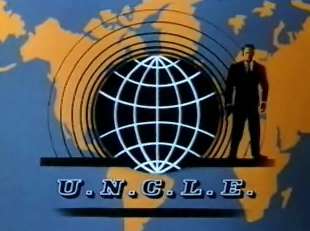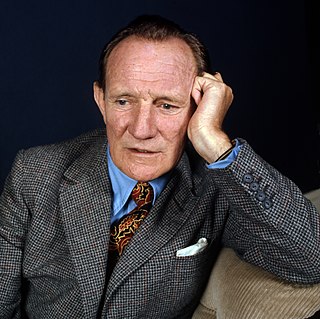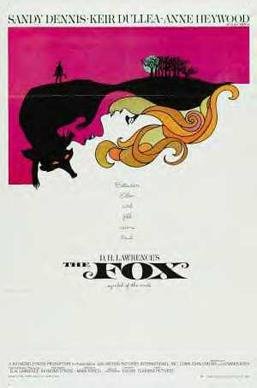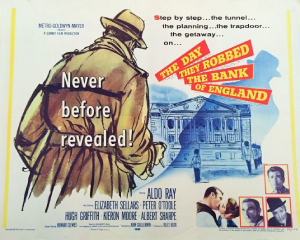
The Man from U.N.C.L.E. is an American spy fiction television series produced by Metro-Goldwyn-Mayer Television and first broadcast on NBC. The series follows secret agents, played by Robert Vaughn and David McCallum, who work for a secret international counterespionage and law-enforcement agency called U.N.C.L.E. The series premiered on September 22, 1964, and completed its run on January 15, 1968. The program led the spy-fiction craze on television, and by 1966 there were nearly a dozen imitators. Several episodes were successfully released to theaters as B movies or double features. There was also a spin-off series, The Girl from U.N.C.L.E., a series of novels and comic books, and merchandising.

Trevor Wallace Howard-Smith was an English stage, film, and television actor. After varied work in the theatre, he achieved star status with his role in the film Brief Encounter (1945), followed by The Third Man (1949).

Rodney Sturt Taylor was an Australian actor. He appeared in more than 50 feature films, including The Time Machine (1960), The Birds (1963), and Inglourious Basterds (2009), and voiced the lead role in One Hundred and One Dalmatians (1961).

Rush Hour 2 is a 2001 American buddy action comedy film directed by Brett Ratner and written by Jeff Nathanson, based on the characters created by Ross LaManna. A sequel to Rush Hour, it is the second installment in the Rush Hour franchise and stars Jackie Chan and Chris Tucker reprising their roles from the first film. The story follows Chief Inspector Lee (Chan) and LAPD Detective James Carter (Tucker), who go to Hong Kong on vacation only to be thwarted by a murder case involving two U.S. customs agents after a bombing at the American embassy. Lee suspects that the crime is linked to the Triad crime lord Ricky Tan (Lone).
Boysie Oakes is fictional secret agent created by the British spy novelist John Gardner in 1964 at the height of a period of fictional spy mania.

John Edmund Gardner was an English spy and thriller novelist, best known for his James Bond continuation novels, but also for his series of Boysie Oakes books and three continuation novels containing Sir Arthur Conan Doyle's fictional villain, Professor Moriarty.

The Glass Bottom Boat is a 1966 American romantic spy comedy film directed by Frank Tashlin and starring Doris Day, Rod Taylor, and Arthur Godfrey, with John McGiver, Paul Lynde, Edward Andrews, Eric Fleming, Dom DeLuise, and Dick Martin. It is also known as The Spy in Lace Panties.

The Fox is a 1967 Canadian drama film directed by Mark Rydell. The screenplay by Lewis John Carlino and Howard Koch is loosely based on the 1923 novella of the same title by D. H. Lawrence. The film marked Rydell's feature film directorial debut.

The Amityville Horror is a 1979 American supernatural horror film directed by Stuart Rosenberg, and starring James Brolin, Margot Kidder, and Rod Steiger. The film follows a young couple who purchase a home haunted by combative supernatural forces. It is based on Jay Anson's 1977 book of the same name, which documented the alleged paranormal experiences of the Lutz family who briefly resided in the Amityville, New York home where convicted killer Ronald DeFeo Jr. committed the mass murder of his family in 1974. It is the first entry in the long-running Amityville Horror film series, and was remade in 2005.

The Day They Robbed the Bank of England is a 1960 British crime film directed by John Guillermin. It was written by Howard Clewes and Richard Maibaum and based upon the 1959 novel of the same title by John Brophy.
Hunter was an Australian espionage adventure television series screened by the Nine Network from Tuesday 4 July 1967 to March 1969. The series was created by Ian Jones and produced by Crawford Productions.

Kim is a 1950 adventure film made in Technicolor by Metro-Goldwyn-Mayer. It was directed by Victor Saville and produced by Leon Gordon from a screenplay by Helen Deutsch, Leon Gordon and Richard Schayer, based on the classic 1901 novel of the same name by Rudyard Kipling.
Joseph Thomas Porcaro was an American jazz drummer.

Our Man in Marrakesh is a 1966 British comedy spy film shot in Morocco produced and co-written by Harry Alan Towers, directed by Don Sharp and starring Tony Randall, Herbert Lom and Senta Berger.

Dark of the Sun is a 1968 British adventure war film starring Rod Taylor, Yvette Mimieux, Jim Brown, and Peter Carsten. The film, which was directed by Jack Cardiff, is based on Wilbur Smith's 1965 novel, The Dark of the Sun. The story about a band of mercenaries sent on a dangerous mission during the Congo Crisis was adapted into a screenplay by Ranald MacDougall. Critics condemned the film on its original release for its graphic scenes of violence and torture.

Where the Spies Are is a 1966 British comedy adventure film directed by Val Guest and starring David Niven, Françoise Dorléac, John Le Mesurier, Cyril Cusack and Richard Marner. It was based on the 1964 James Leasor book Passport to Oblivion, which was also the working title of the film. MGM intended to make a Jason Love film series, but the idea was shelved.

Hot Enough for June is a 1964 British spy comedy film directed by Ralph Thomas, and starring Dirk Bogarde with Sylva Koscina in her English film debut, Robert Morley and Leo McKern. It is based on the 1960 novel The Night of Wenceslas by Lionel Davidson. The film was cut by twenty minutes and retitled Agent 8+3⁄4 for the US release by the American distributor Continental Distributing.

The Liquidator (1964) was the first novel written by John Gardner and the first novel in his Boysie Oakes series.

The Liquidator is a soundtrack album to the motion picture The Liquidator by Argentine composer, pianist and conductor Lalo Schifrin recorded in 1965 and released on the MGM label. An expanded edition of the soundtrack was released by Film Score Monthly in 2006. Shirley Bassey, then well known for her Goldfinger title song performed two versions of the theme; a hard driving main title theme and a softer romantic version called My Liquidator. Due to the delayed release of the film, the soundtrack was issued later in 1966
















